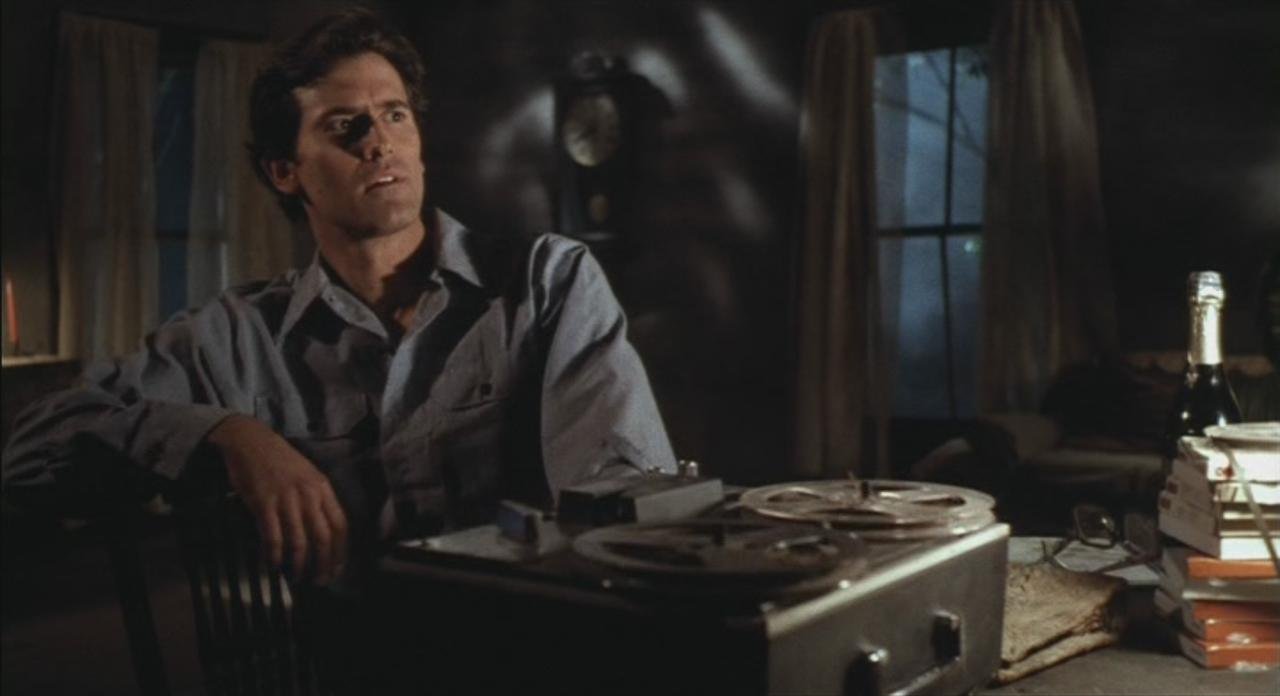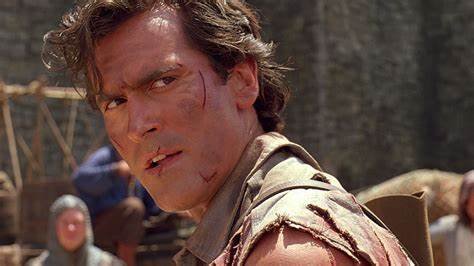[Editorial] Dead By Dawn: A Retrospect on the Original Evil Dead Trilogy

With the recent release of Lee Cronin’s Evil Dead Rise, The Evil Dead franchise has encountered a resurgence from its bloody grave, resurrecting once again the Deadite demon entities and their reign of terror and violent chaos against any humans they possess and everyone that comes into contact with them.
Removed from the original setting of a remote cabin in the woods, yet still retaining the isolation factor and centering the film within a condemned apartment building, torn apart by an earthquake, Evil Dead Rise not only forges a new story for itself within the Deadite-verse, but also has harkbacks to the original trilogy interwoven through its DNA. If Cronin’s entry is the festering yet reanimated corpse of the franchise, Sam Raimi’s original is the skeletal system holding it all together.
The Evil Dead (1981) was born after childhood friends Sam Raimi and Bruce Campbell decided to genre shift from their original penchant for low budget comedy films. Initially titled Book Of The Dead, Raimi’s story was influenced by his interest in the cosmic horror writer H.P. Lovecraft, centering around a group of college kids vacationing in a remote cabin in the middle of a forest.
After discovering a basement containing an ancient Book of The Dead and an archaeologist's recordings, they inadvertently release a demonic entity that will soon possess the majority of the group, leaving Ash Williams (Bruce Campbell) to fight off the impending hordes of violent demons. After making a short film version called Into the Woods as a proof of concept for would-be investors, filming began on The Evil Dead on location in an isolated cabin surrounded by trees in rural Tennessee.

The cast and crew of The Evil Dead mainly consisted of thirteen of Raimi’s friends and family, who all stayed in the cabin for the duration of filming. Shooting was in itself horrific for all involved, the cabin had no plumbing and due to its isolated location, medical assistance was extremely difficult to arrange even with all of the onset injuries that occurred during principal photography that included Betsey Baker’s eyelashes being ripped out of her eyelids when she removed her Linda mask and Bruce Campbell injuring his leg. Morale on set was low and the crew- who had been getting sick due to the conditions- had resorted to burning the cabin’s furniture in order to stay warm. Raimi held the belief that if he kept his cast and crew completely miserable and tortured during filming, they would deliver an authentic horror performance.
While filming The Evil Dead Sam Raimi began to develop his personal directorial style, creating a sense of mise-en-scene that consisted of techniques such as Dutch camera angles which involves tilting the camera so that horizon lines are non-parallel with the bottom of the frame to create a sense of tension and the uncanny. Due to the production’s budgetary restrictions, devices such as Steadicams needed to be emulated inexpensively, and so to create the roaming shots from the point of view of the demonic entity stalking the characters through the forest, the camera was mounted onto a plank of wood and two camera operators would run through the trees, hoping to avoid large roots and jumping over rocks and pits in the ground. The final scene was filmed with the camera being mounted on a bike which was ridden at speed to create a fluid movement. The film uses a considerable amount of prosthetics as well as stop animation, done by artist Tom Sullivan. Though quite rudimentary in form, the practical effects contributed to The Evil Dead being labelled as the number one video nasty by Mary Whitehouse during the video nasty phenomenon of the 1980s in Britain.
LISTEN TO OUR HORROR PODCAST!
![[Ghouls Podcast] Ghouls Watch: Bucket List of the Dead, Blood Drive, Candy Land & more](https://images.squarespace-cdn.com/content/v1/5fe76a518d20536a3fbd7246/1696261000263-58VQFOVWPE363OFGP7RF/GHOULS+WATCH.jpg)
After filming wrapped in January of 1980, and editing was completed by Edna Paul and assistant Joel Coen (Of the Coen Brothers), Irvin Shapiro took on the job for worldwide distribution of The Evil Dead. After its screening at the 1982 Cannes Film Festival, Stephen King would give the film a rave review, thus securing distribution from New Line Cinema, as well as attracting the attention of film critics. Despite international box office success, The Evil Dead didn’t quite cement Sam Raimi’s reputation as an established horror director, but it was definitely the first solid stepping-stone for both himself and his star Bruce Campbell towards cult status.
In 1986, after Raimi’s comedy film Crimewave (1985) flopped both commercially and critically, publicist Irvin Shapiro persuaded Raimi to begin work on a sequel to The Evil Dead. With the help of Stephen King, due to his support of the first film, the sequel garnered considerable financial backing from producer Dino De Laurentiis who, despite Raimi already having written a premise set in the Middle Ages, insisted the film follow a similar plot line as the first film. Instead of being a direct sequel, Evil Dead 2 rewrites the first film, following Ash as he and his girlfriend travel to the remote cabin in the woods to spend some quality time together. Just like the first one, they manage to release the demonic deadites who seek to devour their souls after playing the recording of an incantation from the Necronomicon.

After having to kill his possessed girlfriend, Ash is then joined in the cabin by the original occupant’s daughter and her research partner to gather together the missing pages of the Necronomicon, and then attempt to send the demons to another dimension. The final sequence concludes with Ash being sucked into the vortex, only to land, to his horror, into The Middle Ages in a land being attacked by a flying Kandarian demon.
Whereas the first instalment of the franchise was straightforward horror, Evil Dead 2 (1987) leaned more into Raimi’s comedic roots, yet still retaining its heavy use of practical effects thanks to the returning work of Tom Sullivan, as well as a team that featured special FX artist Greg Nicotero. The film was a critical success, with some believing it to be better than its predecessor and would lay the path forward for the third film of the franchise to grow into fruition.
Despite Raimi originally having had the idea for a third Evil Dead film prior to filming of the sequel, the 14th century set horror comedy wasn’t greenlit until Raimi had achieved success with his adaptation of Darkman (1990). Given its title by Ivan Shapiro, Army of Darkness was partially written during the production of Darkman by both Sam and his brother Ivan Raimi, and eventually completed once Darkman had wrapped. With Ivan Shapiro’s multi movie deal with Universal coming into play, Army of Darkness gained the studio’s financial backing and commenced filming in 1991.
Army of Darkness picks up where Evil Dead 2 leaves off. Ash Williams (played by returning star Bruce Campbell) finds himself trapped in the 1300s having been taken prisoner by Lord Arthur after being suspected of espionage for the opposing Duke Henry. Ash proves himself through the killing of a deadite and is hailed a hero, learning that to be able to get back to his own time, he must search for the Necronomicon. Due to Ivan’s penchant for comedic writing, Army of Darkness contains scenes that border on the absurd, such as a group of mini-Ash’s that violently terrorise the hero, eventually forcing him to swallow one of them before he then grows an evil twin who becomes the movie’s main antagonist.

Also included are stop motion skeletons, a prominent homage to Ray Harryhausen’s work in Jason and The Argonauts (1963) continuing on the trilogy’s combination of practical effects with claymation stop animation. With a lukewarm reception at the time of release, Army of Darkness has gone on to become a cult classic in the same vein as the first two instalments of the franchise.
LISTEN TO OUR HORROR PODCAST!
The Evil Dead trilogy has become one of the most beloved franchises in the horror genre, enabling Sam Raimi to cement himself as an auteur in cinema. His career has catapulted from indie micro-budget horror filmmaker to a Marvel cinematic universe darling having directed the first Spiderman trilogy (2002-2007) as well as more recently Doctor Strange in the Multiverse of Madness (2022). The franchise has also catapulted Bruce Campbell into final boy cult status, his turn as Ash endearing him to genre fans. The original trilogy has laid the groundwork for emerging filmmakers like Evil Dead (2013) director Fede Álvarez and Evil Dead Rise (2023) director Lee Cronin to begin the work of expanding a Deadite-verse safe in the knowledge that they are continuing the legendary yet terrifying legacy of Sam Raimi’s Evil Dead.


![[Ghouls Podcast] Tender Is The Flesh with Zoë Rose Smith, Bel Morrigan and Liz Bishop](https://images.squarespace-cdn.com/content/v1/5fe76a518d20536a3fbd7246/1693769261264-MS4TS4Z4QC1N15IXB4FU/Copy+of+%5BJuly%5D+Antiviral%2C+possesoor+and+infinity+pool.jpg)
![[Ghouls Podcast] Antiviral, Possessor & Infinity Pool with Zoë Rose Smith, Amber T and Iona Smith](https://images.squarespace-cdn.com/content/v1/5fe76a518d20536a3fbd7246/1691238787263-XYRKXW2Z7RWI9AY2V2GX/%5BJuly%5D+Antiviral%2C+possesoor+and+infinity+pool+%281%29.jpg)
![[Ghouls Podcast] Ghouls Watch: Body Horror Recommendations](https://images.squarespace-cdn.com/content/v1/5fe76a518d20536a3fbd7246/1691238687847-L9U434I1U4HZ3QMUI3ZP/%5BJuly%5D+Ghouls+Watch+-+Website+%281%29.jpg)
![[Ghouls Podcast] Ghouls Watch: Bones and All, Suitable Flesh, The Human Centipede & more](https://images.squarespace-cdn.com/content/v1/5fe76a518d20536a3fbd7246/1687855203348-7R2KUSNR6TORG2DKR0JF/%5BJune%5D+Ghouls+Watch+-+Website.jpg)
![[Ghouls Podcast] 3 Original vs. Remake Horror Films with Rebecca McCallum & Kim Morrison](https://images.squarespace-cdn.com/content/v1/5fe76a518d20536a3fbd7246/1685286663069-0Q5RTYJRNWJ3XKS8HXLR/%5BJune%5D+Original+vs.+Remake+Horror+Films.png)
![[Ghouls Podcast] Ghouls Watch: The Devil’s Candy, Morgana, Dead Ringers & more](https://images.squarespace-cdn.com/content/v1/5fe76a518d20536a3fbd7246/1685284429090-5XOOBIOI8S4K6LP5U4EM/%5BMay%5D+Ghouls+Watch+-+Website.png)
![[Ghouls Podcast] The Ruins (2008) with Ash Millman & Zoë Rose Smith](https://images.squarespace-cdn.com/content/v1/5fe76a518d20536a3fbd7246/1684076097566-BE25ZBBECZ7Q2P7R4JT4/The+Ruins.jpg)
![[Ghouls Podcast] Ghouls Watch: Deathproof, Child’s Play, Ghostwatch & more](https://images.squarespace-cdn.com/content/v1/5fe76a518d20536a3fbd7246/1682447065521-DWF4ZNYTSU4NUVL85ZR0/ghouls+watch.png)
![[Ghouls Podcast] 5 Coming-of-Age Horror Film Recommendations](https://images.squarespace-cdn.com/content/v1/5fe76a518d20536a3fbd7246/1681418402835-EMZ93U7CR3BE2AQ1DVH4/S2+EP5.png)
![[Ghouls Podcast] Good For Her Horror Film Recommendations](https://images.squarespace-cdn.com/content/v1/5fe76a518d20536a3fbd7246/1678634497037-W441LL37NW0092IYI57D/Copy+of+Copy+of+GHOULS+PODCAST+THE+LOVED+ONES.jpg)
![[Ghouls Podcast] Ghouls Watch: Severance, Run Sweetheart Run, Splice & more](https://images.squarespace-cdn.com/content/v1/5fe76a518d20536a3fbd7246/1677589685406-YZ9GERUDIE9VZ96FOF10/Copy+of+GHOULS+PODCAST+THE+LOVED+ONES+%281%29.jpg)
![[Ghouls Podcast] The Loved Ones (2009) with Liz Bishop](https://images.squarespace-cdn.com/content/v1/5fe76a518d20536a3fbd7246/1676369735666-56HEK7SVX9L2OTMT3H3E/GHOULS+PODCAST+THE+LOVED+ONES.jpg)
![[Ghouls Podcast] Terrifier (2016) & Terrifier 2 (2022) with Janine Pipe](https://images.squarespace-cdn.com/content/v1/5fe76a518d20536a3fbd7246/1674478017541-0DHH2T9H3MVCAMRBW1O1/_PODCAST+NO+IMAGE+2023+EP+4+%282%29.jpg)
![[Ghouls Podcast] Krampus (2015) with Megan Kenny & Rebecca McCallum](https://images.squarespace-cdn.com/content/v1/5fe76a518d20536a3fbd7246/1672839790368-VYX6LIWC5NVVO8B4CINW/_PODCAST+NO+IMAGE+2023+EP+17.jpg)
![[Ghouls Podcast] Soho Horror Film Review with Hannah Ogilvie & Caitlyn Downs](https://images.squarespace-cdn.com/content/v1/5fe76a518d20536a3fbd7246/1672840392291-XQGQ94ZN9PTC4PK9DTN1/_PODCAST+NO+IMAGE+2023+EP+16.jpg)
![[Ghouls Podcast] The Borderlands (2013) with Jen Handorf](https://images.squarespace-cdn.com/content/v1/5fe76a518d20536a3fbd7246/1672839985316-KPLOVA9NGQDAS8Z6EIM9/_PODCAST+NO+IMAGE+2023+EP+15.jpg)
![[Ghouls Podcast] Soho Horror Film Preview with Hannah Ogilvie & Caitlyn Downs](https://images.squarespace-cdn.com/content/v1/5fe76a518d20536a3fbd7246/1672840411619-IP54V5099H6QU9FG4HJP/_PODCAST+NO+IMAGE+2023+EP+14.jpg)
![[Ghouls Podcast] Halloween Special: 5 Horror Films to Watch This Halloween with Joshua Tonks and Liz Bishop](https://images.squarespace-cdn.com/content/v1/5fe76a518d20536a3fbd7246/1672840351086-2AWFIS211HR6GUY0IB7I/_PODCAST+NO+IMAGE+2023+EP+13.jpg)
![[Ghouls Podcast] Horror Literature with Nina Book Slayer & Alex Bookubus](https://images.squarespace-cdn.com/content/v1/5fe76a518d20536a3fbd7246/1672840273346-ASHBRDHOKRHMGRM9B5TF/_PODCAST+NO+IMAGE+2023+EP+12.jpg)
![[Ghouls Podcast] Alien with Tim Coleman and Rebecca McCallum](https://images.squarespace-cdn.com/content/v1/5fe76a518d20536a3fbd7246/1672839878802-LR40C39YGO3Q69UCCM62/_PODCAST+NO+IMAGE+2023+EP+11.jpg)
![[Ghouls Podcast] Final Destination with Jenn Adams and Rebecca McCallum](https://images.squarespace-cdn.com/content/v1/5fe76a518d20536a3fbd7246/1672839916928-KK9CTT0OAKACXLGYA9DX/_PODCAST+NO+IMAGE+2023+EP+10.jpg)
![[Ghouls Podcast] Dark Water with Melissa Cox and Rebecca McCallum](https://images.squarespace-cdn.com/content/v1/5fe76a518d20536a3fbd7246/1672839939630-BLPIHIDVRJE9FC1A9BRZ/_PODCAST+NO+IMAGE+2023+EP+9.jpg)
![[Ghouls Podcast] Noroi: The Curse & Perfect Blue with Sarah Miles and Ygraine Hackett-Cantabrana](https://images.squarespace-cdn.com/content/v1/5fe76a518d20536a3fbd7246/1682950816911-7ZCMPP8H0BSUPCPZYQ07/_PODCAST%2BNO%2BIMAGE%2B2023%2BEP%2B8.jpg)
![[Ghouls Podcast] The Wicker Man with Lakkaya Palmer](https://images.squarespace-cdn.com/content/v1/5fe76a518d20536a3fbd7246/1672839898764-VIYDC7ZD8QTBCGK562NL/_PODCAST+NO+IMAGE+2023+EP+7.jpg)
![[Ghouls Podcast] You Are Not My Mother with Ygraine Hackett-Cantabrana](https://images.squarespace-cdn.com/content/v1/5fe76a518d20536a3fbd7246/1672840165939-VP0CIKOM4KPX67JLNHDB/_PODCAST+NO+IMAGE+2023+EP+6.jpg)
![[Ghouls Podcast] Interview with a Vampire & Bram Stoker’s Dracula with Dr. Harriet Fletcher](https://images.squarespace-cdn.com/content/v1/5fe76a518d20536a3fbd7246/1672840081289-714FCGZ8MYU4BUG9RRWC/Copy+of++PODCAST+NO+IMAGE+2023+EP+5.jpg)
![[Ghouls Podcast] Let The Right One in with Iona Smith](https://images.squarespace-cdn.com/content/v1/5fe76a518d20536a3fbd7246/1672840623893-Y1MMPNYPDEPGI9J5BJC8/_PODCAST+NO+IMAGE+2023+EP+4+%281%29.jpg)





















![[Ghouls Podcast] The Invitation with Hannah Ogilvie](https://images.squarespace-cdn.com/content/v1/5fe76a518d20536a3fbd7246/1672838145193-OW65KNC5POZN5FE5KZHK/_PODCAST+NO+IMAGE+2023+EP+3.jpg)
![[Ghouls Podcast] Trouble Every Day with Amber T](https://images.squarespace-cdn.com/content/v1/5fe76a518d20536a3fbd7246/1672837846372-19MMMAF5WCOORZXNRIY3/_PODCAST+NO+IMAGE+2023+EP+2.jpg)
![[Editorial] Soho Horror Film Festival: Interview with Aimee Kuge on Cannibal Mukbang](https://images.squarespace-cdn.com/content/v1/5fe76a518d20536a3fbd7246/1701808004722-9M8SZ2UXY52QBQBR4NTI/img20230818_15150780.JPG)
![[Editorial] 10 Films & Events to Catch at Soho Horror Film Fest 2023](https://images.squarespace-cdn.com/content/v1/5fe76a518d20536a3fbd7246/1700819417135-299R7L4P0B676AD3RO1X/Screenshot+2023-11-24+at+09.41.52.png)
![[Editorial] 9 Horror Nintendo Switch Games To Play](https://images.squarespace-cdn.com/content/v1/5fe76a518d20536a3fbd7246/1697214470057-3XZXX8N4LYIMDFWS6Z3P/Screenshot+2023-10-13+at+17.20.13.png)
![[Mother of Fears] Mothering in Silence in A Quiet Place (2018)](https://images.squarespace-cdn.com/content/v1/5fe76a518d20536a3fbd7246/1696445921315-HZJ2DZYQIH6VVWXBO2YL/Screenshot+2023-10-04+at+19.52.29.png)
![[Event Review] Highlights from Mayhem Film Festival 2023](https://images.squarespace-cdn.com/content/v1/5fe76a518d20536a3fbd7246/1697624582491-MPT2VB9RRGU6OG7L6UKL/Mayhem+2023.jpg)
![[Editorial] Mayhem Festival: Interview with Thomas Sainsbury on Loop Track (2023)](https://images.squarespace-cdn.com/content/v1/5fe76a518d20536a3fbd7246/1697186472899-WC4RR0TW7L7LMFEBGPA2/Tom+Sainsbury.jpg)
